Desert Mistletoe: Photos of 'Tree Thieves' in the American Southwest
This is the time of year when hanging mistletoe beckons loving couples to share a romantic moment. But, in the desert regions of northern Mexico and in the American Southwest, a very different type of mistletoe can be found. Check out these fascinating photos of desert mistletoe.
Romance calls
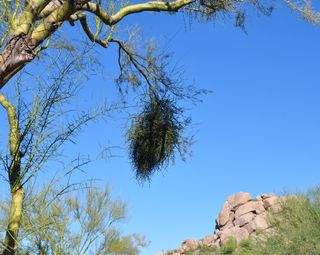
Desert mistletoe (Phorodendron californicum), unlike its commonly hung broadleaf cousins sold during this festive season, may not be so welcoming to those looking to steal a holiday kiss, since it grows in trees and shrubs covered with thorns. (Photos credit: Linda & Dr. Dick Buscher)
Parasitic plants

The desert mistletoe is a common perennial found in the Mojave and Sonoran Deserts, locations that are less than 4,000 feet (1,220 meters) in elevation. The plant is a hemiparasite, which means it carries out photosynthesis in its many green stems while obtaining additional nutrients and water from the host plant upon which it grows. (Photos credit: Linda & Dr. Dick Buscher)
The favorite hosts

In these arid regions, the desert mistletoes’ most common host plants are the desert legume trees and shrubs that grow there. The common varieties of mesquite, palo verde, and ironwood, Olneya tesota, trees as well as an occasional catclaw acacia, Acacia greggii, creosote bush, Larrea tridentata and the varieties of desert buckthorn shrubs play host to these slow-growing invaders. (Photos credit: Linda & Dr. Dick Buscher)
Sign up for the Live Science daily newsletter now
Get the world’s most fascinating discoveries delivered straight to your inbox.
It takes all kinds
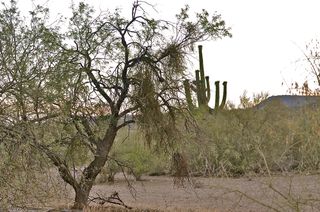
There are more than 1,000 species of mistletoe found around the world. Desert mistletoe belongs to the genus Phorodendron. Phorodendron translates to mean, "tree thief." Desert mistletoe is also known in some desert areas by the name mesquite mistletoe. (Photos credit: Linda & Dr. Dick Buscher)
What to look for

In the trees and bushes of this desert region, desert mistletoe often looks like a dense nest or hive. In reality, desert mistletoe is a dense cluster of brittle, jointed green stems that are primarily leafless. The clusters tend to hang down from the host and can grow to lengths of 36 inches (1 m) in six to eight years. (Photos credit: Linda & Dr. Dick Buscher)
Blooms to fruit

This non-aggressive pathogen’s leaves have been reduced to scales. The tiny, petal-less flowers bloom from January to March, and are known for producing a strong fragrance. Shortly after blooming, the flowers produce an abundance of red fruit. (Photos credit: Linda & Dr. Dick Buscher)
Spreading the growth
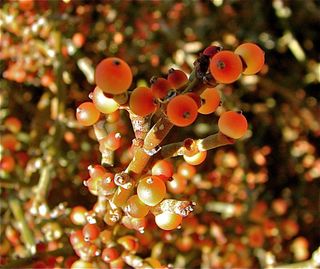
The seeds of the fruit are covered with a gelatinous material that makes them extremely sticky. They are a favorite food for the birds of the desert that often get the sticky seeds stuck to their beaks or feet. As they wipe their beaks and feet clean on another branch, or even another tree, the mistletoe seeds now become planted on a new potential host. Since the seeds also have a tough seed coat, they easily pass through the bird’s digestive system and become deposited onto new branches through their droppings. (Photos credit: Linda & Dr. Dick Buscher)
A win-win situation
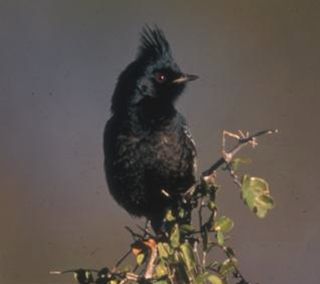
The Phainopepla (Phainopepla nitens), commonly known as a Silky Flycatcher, is a small, desert bird that seems to have a special relationship with desert mistletoe. The black, male Phainopepla looks like a miniature cardinal. The mistletoe berries are the bird’s main source of food in the winter. As such, the Phainopepla is one of the birds primarily responsible for the distribution of desert mistletoe seeds. (Photo credit: NPS)
The 'prey'

Desert mistletoe seeds can germinate on any branch of the tree but its small, rootlike structures called haustoria can only penetrate young, thin bark. The haustoria grow in the microscopic spaces between the host plant cells, extracting water from the host xylem and nutrients from the host cells. (Photos credit: Linda & Dr. Dick Buscher)
A long-term relationship
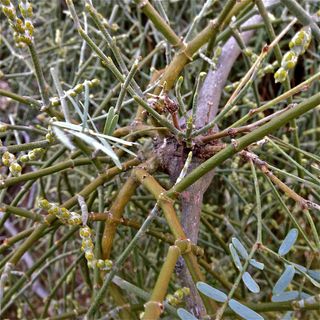
Once the haustoria penetrates and begins to grow within a tree branch, it takes between two to three years for the first shoots of brittle stems to begin to grow. Once stem growth begins, it takes another year of maturing before the desert mistletoe begins to produce fruit. Botanists calculate that desert mistletoe plants can grow on their hosts for 60 to 70 years. (Photos credit: Linda & Dr. Dick Buscher)
Living out life

If desert mistletoe is a killer, it is surely a slow one. Death to a host tree usually occurs only when multiple clusters of mistletoe overtake the host tree, or when the host is weakened by other diseases or by a lack of water. Death of a host caused solely by mistletoe is very uncommon. (Photos credit: Linda & Dr. Dick Buscher)
Useful for life

Man has long used the desert mistletoe for his survival. Both the indigenous Tohono O’odham and Seri people of this desert region ate the sweet mistletoe fruits that grew on mesquite, ironwood and acacia. They avoided the fruits that grew on desert buckthorn and palo verde, as they are bitter and were considered inedible. The Akimel O’odham, River Pima, crushed the berries and made a sweet pudding. The Seri people were also known to make a strong medicinal drink by boiling the plant’s jointed stems. (Photos credit: Linda & Dr. Dick Buscher)
Counting on each other

The relationship between the trees and shrubs of the Mohave and Sonoran Deserts and the desert mistletoe is very old. Over the millennia they all have learned to survive together in this very arid and harsh environment. Even though one uses the others for survival, all have come to deal with each other and are able to co-exist together. (Photos credit: Linda & Dr. Dick Buscher)
Follow us @livescience, Facebook & Google+.
Most Popular


